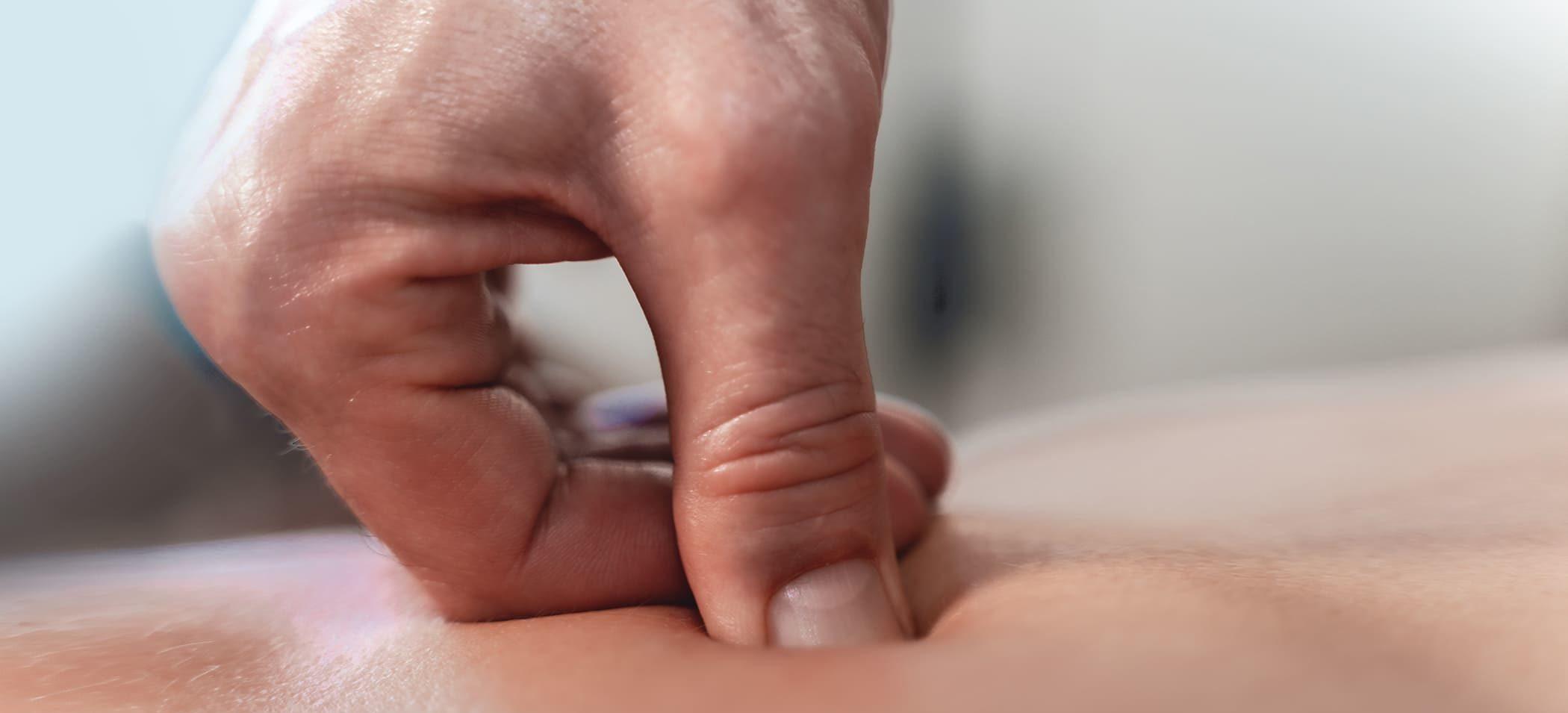Trigger Point Therapy Zurich
The trigger point is a small muscle spasm that is often felt like a knot or small ball and that reacts painfully to pressure.
When a muscle tightens, it strengthens up to the fibre level. Normally a muscle loosens and relaxes completely. If the muscle cramps instead, however, the smallest muscle fiber areas, the so-called sarcomeres, remain hard.
This creates a trigger point. This tension does not only have a local effect, but the pain also manifests itself in distant areas of the body. For example, pain may be caused by pain points in the abdominal muscles.
AVAILABLE THERAPISTS
We couldn't find any therapist for your query
PRICES TRIGGER POINT THERAPY
45 minutes: 115 CHF
60 minutes: 135 CHF
75 minutes: 162 CHF
90 minutes: 192 CHF
Costs covered by health insurance 50%-90%.
No prescription from a doctor is necessary.
Most supplementary insurances cover the costs of a massage. Go to our health insurance page, select your supplementary insurance and see what therapists are recognised with your insurance.
What are the causes of trigger points?
How does trigger point therapy help?
- Devolution of metabolites
- local strongly improved blood circulation up to 500%
When treating pain, the therapist looks for the most pain-sensitive area in the loaded muscle. This is often the place where the nerve enters the muscle. The therapist puts strong pressure on the so-called trigger point and hits or circles the affected area with his fingers. Thus the masseur stimulates the metabolism.
In the ideal case, the muscle is completely supplied with blood again after the treatment and can relax. The better this succeeds, the more the pain in the affected area is reduced. A concluding massage of the entire body part deepens the relaxation. Finally, it must be mentioned that trigger point therapy is often painful. It brings relief without side effects.
What problems does she help with?
- headaches, migraine
- Dizziness
- shoulder pain
- neck pain
- Rück pain
- knee pain
- Whiplash trauma
- breast pain (narrow vein)
- Golf bow or tennis elbow
- witch shot
- achilles tendon pain
- tendon insertions
- arthrosis
- Tinnitus, ringing in the ears, fall from the horn
- various chronic conditions
- digestive complaints
For almost all complaints, the treatment can have a healing or at least supportive and pain-relieving effect. Pücke pain, for example, is often not caused by vertebral problems. In the vast majority of cases, they are the result of incorrect posture and overload. The musculature contains one or more trigger points, so that larger areas tense up and become noticeable as pain.
Joint pain, tennis elbow and golf elbow also have their origin in protective postures and/or overstraining. The body is no longer moved ergonomically. Joints and arms are incorrectly loaded and react with pain.
A tense shoulder musculature affects the head area. Arms and hands are also affected.
Dizziness, jaw and headaches can also originate from tense muscles. Especially a lot of stress of all kinds causes muscle tension in the whole body.
All these pains, postural problems and overloads can be effectively treated with trigger point therapy. The relaxed muscles can be stretched again and moved normally. A healthy posture is again possible. The treatment thus helps to avoid pain in the long term.
OUR OFFERS
MOST BOOKED MASSAGE
Classical massage
For normal tension without severe pain, book the Classic Massage.
Medical Massage
When you suffer from acute or chronic pain book a medical massage.
Sports massage
A massage with strong pressure. It can be used for the prevention and regeneration of the body before and after workouts.
Pregnancy massage
From the first month you can come to us for massage. The treatment is adjusted to the month of pregnancy.
Myofascial release
The aim is to detach different tissue layers from each other in order to eliminate discomfort.
Trigger point therapy
Pain points in the muscle are treated, which are often perceived as punctual hardenings and trigger pain.
Deep Tissue Massage
This involves working with a lot of pressure in depth and loosening fascia and muscles.
Lymphatic Drainage
In the case of swellings that occur, among other things, after operations or weakness of the veins, pregnancy, etc., the water in the tissues is eliminated more quickly here by lymphatic drainage.
Foot reflexology massage
The entire body can be influenced and brought back into balance via the foot reflex zones.
THERAPEUTICAL MASSAGE
Dorn Therapy
Acupuncture massage
A holistic and natural pain therapy concept from Switzerland
Relaxation Massage
The therapist combines different techniques (manual & energetic) and works on all levels (body, mind, soul).
Tuina
A holistic manual therapy method from Traditional Chinese Medicine. The therapist works along energy pathways and acupuncture points.
RELAXATION MASSAGE
Relaxation Massage
You want to relax deeply and let go? Then the relaxing massage is your optimal choice.
Couples Massage
Let the two of you pamper yourselves in the same room. An ideal gift to your loved ones for a birthday, Mother's Day, birth or just to give a little relaxation.
Lomi lomi massage
A traditional Hawaiian method, known for its flowing rhythmic massage techniques, mobilizations and stretches throughout the musculoskeletal system.
Shiatsu
Shiatsu works with energy pathways, the so-called meridians. The goal is to bring the energy back to its original and perfect flow

